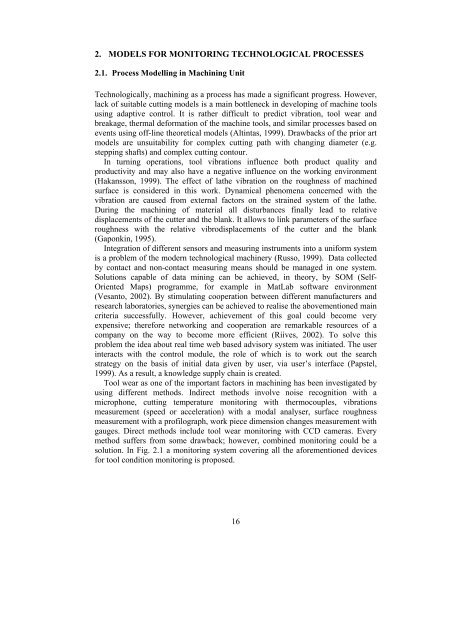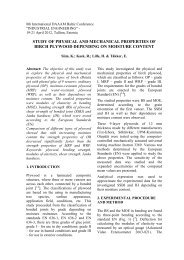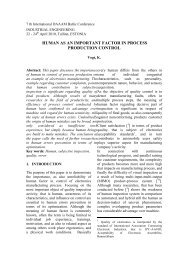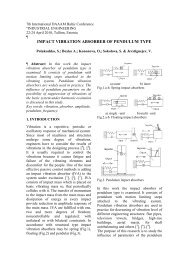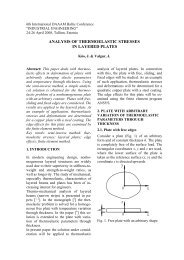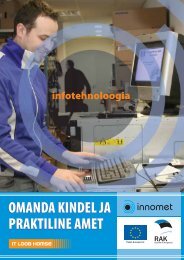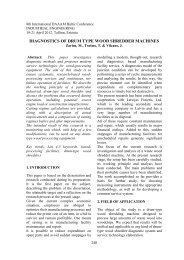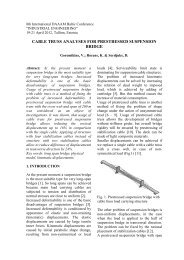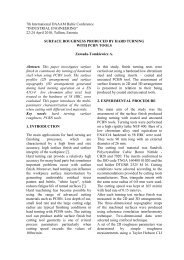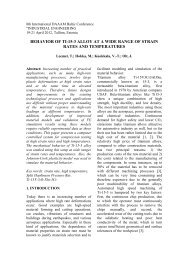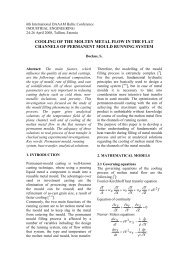Overview in PDF format - Tallinna Tehnikaülikool
Overview in PDF format - Tallinna Tehnikaülikool
Overview in PDF format - Tallinna Tehnikaülikool
You also want an ePaper? Increase the reach of your titles
YUMPU automatically turns print PDFs into web optimized ePapers that Google loves.
2. MODELS FOR MONITORING TECHNOLOGICAL PROCESSES2.1. Process Modell<strong>in</strong>g <strong>in</strong> Mach<strong>in</strong><strong>in</strong>g UnitTechnologically, mach<strong>in</strong><strong>in</strong>g as a process has made a significant progress. However,lack of suitable cutt<strong>in</strong>g models is a ma<strong>in</strong> bottleneck <strong>in</strong> develop<strong>in</strong>g of mach<strong>in</strong>e toolsus<strong>in</strong>g adaptive control. It is rather difficult to predict vibration, tool wear andbreakage, thermal de<strong>format</strong>ion of the mach<strong>in</strong>e tools, and similar processes based onevents us<strong>in</strong>g off-l<strong>in</strong>e theoretical models (Alt<strong>in</strong>tas, 1999). Drawbacks of the prior artmodels are unsuitability for complex cutt<strong>in</strong>g path with chang<strong>in</strong>g diameter (e.g.stepp<strong>in</strong>g shafts) and complex cutt<strong>in</strong>g contour.In turn<strong>in</strong>g operations, tool vibrations <strong>in</strong>fluence both product quality andproductivity and may also have a negative <strong>in</strong>fluence on the work<strong>in</strong>g environment(Hakansson, 1999). The effect of lathe vibration on the roughness of mach<strong>in</strong>edsurface is considered <strong>in</strong> this work. Dynamical phenomena concerned with thevibration are caused from external factors on the stra<strong>in</strong>ed system of the lathe.Dur<strong>in</strong>g the mach<strong>in</strong><strong>in</strong>g of material all disturbances f<strong>in</strong>ally lead to relativedisplacements of the cutter and the blank. It allows to l<strong>in</strong>k parameters of the surfaceroughness with the relative vibrodisplacements of the cutter and the blank(Gaponk<strong>in</strong>, 1995).Integration of different sensors and measur<strong>in</strong>g <strong>in</strong>struments <strong>in</strong>to a uniform systemis a problem of the modern technological mach<strong>in</strong>ery (Russo, 1999). Data collectedby contact and non-contact measur<strong>in</strong>g means should be managed <strong>in</strong> one system.Solutions capable of data m<strong>in</strong><strong>in</strong>g can be achieved, <strong>in</strong> theory, by SOM (Self-Oriented Maps) programme, for example <strong>in</strong> MatLab software environment(Vesanto, 2002). By stimulat<strong>in</strong>g cooperation between different manufacturers andresearch laboratories, synergies can be achieved to realise the abovementioned ma<strong>in</strong>criteria successfully. However, achievement of this goal could become veryexpensive; therefore network<strong>in</strong>g and cooperation are remarkable resources of acompany on the way to become more efficient (Riives, 2002). To solve thisproblem the idea about real time web based advisory system was <strong>in</strong>itiated. The user<strong>in</strong>teracts with the control module, the role of which is to work out the searchstrategy on the basis of <strong>in</strong>itial data given by user, via user’s <strong>in</strong>terface (Papstel,1999). As a result, a knowledge supply cha<strong>in</strong> is created.Tool wear as one of the important factors <strong>in</strong> mach<strong>in</strong><strong>in</strong>g has been <strong>in</strong>vestigated byus<strong>in</strong>g different methods. Indirect methods <strong>in</strong>volve noise recognition with amicrophone, cutt<strong>in</strong>g temperature monitor<strong>in</strong>g with thermocouples, vibrationsmeasurement (speed or acceleration) with a modal analyser, surface roughnessmeasurement with a profilograph, work piece dimension changes measurement withgauges. Direct methods <strong>in</strong>clude tool wear monitor<strong>in</strong>g with CCD cameras. Everymethod suffers from some drawback; however, comb<strong>in</strong>ed monitor<strong>in</strong>g could be asolution. In Fig. 2.1 a monitor<strong>in</strong>g system cover<strong>in</strong>g all the aforementioned devicesfor tool condition monitor<strong>in</strong>g is proposed.16


